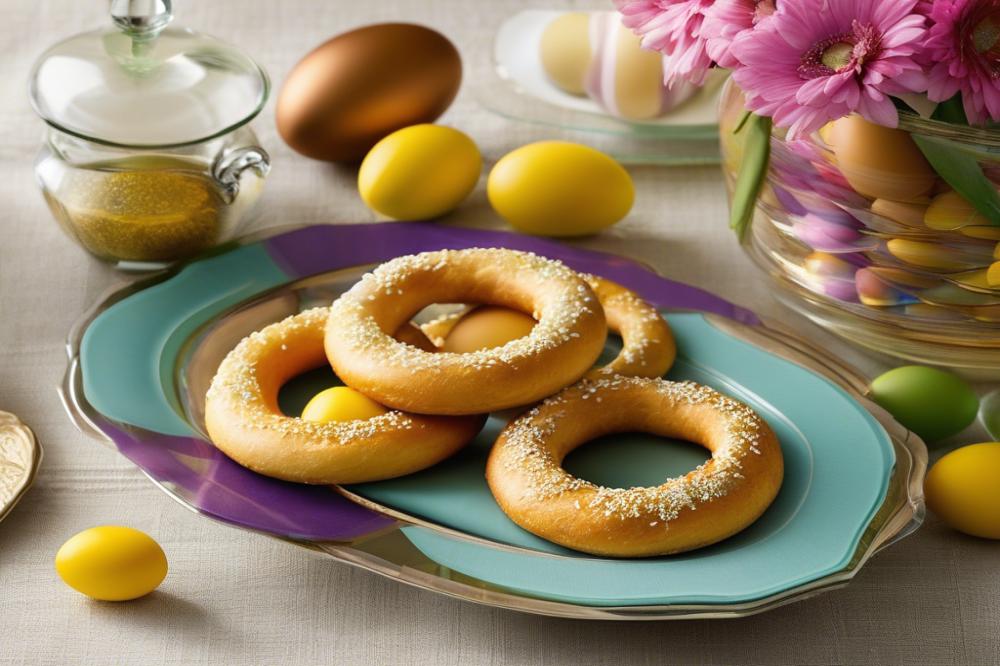Introduction
Easter is a significant celebration in Italian culture. For many families, the holiday represents renewal and hope. Traditions run deep, connecting generations through rituals and customs. Food plays a major role during this festive time, with many specific treats prepared in honor of the holiday.
As families gather to celebrate, a variety of traditional Italian treats grace the tables. Italian cookies, cakes, and pastries hold special places among the offerings. Sweet and savory snacks abound, providing a delightful experience for everyone. Among these delights, homemade taralli stands out as a beloved staple during the Easter season.
Taralli are crunchy snacks made from a special dough. Often flavored with anise, they deliver a unique taste that many enjoy. The crispy texture complements various occasions perfectly. Baking these delectable treats becomes part of the Easter baking tradition, allowing families to come together and create something special. This Taralli recipe highlights the joy of preparing food as a way to celebrate Easter traditions.
Understanding Italian Easter Taralli

Taralli are small, ring-shaped snacks popular in Italy. They have a crispy texture that makes them delightful to eat. Often enjoyed as a treat, they play an important role in Italian cuisine. These snacks are versatile and come in many flavors. traditional Italian recipes often feature these crunchy bites as part of special occasions, particularly during Easter baking. Homemade taralli can be found in many households, especially during festive celebrations.
Regional Variations of Taralli in Italy
Across Italy, you will find different versions of taralli. Each region has its own twist on this classic snack. For instance, in Puglia, taralli are often made with olive oil, giving them a rich flavor. The Naples area is known for adding various spices or even cheese to their dough. In regions like Campania, taralli may be sweetened and served as Italian cookies, perfect for tea or coffee. Such diversity reflects the customs and ingredients of each area, enriching the Italian culinary tradition.
Significance of Anise Flavor in Traditional Recipes
The anise flavor features prominently in many traditional recipes. This herb brings a distinct taste that evokes a sense of nostalgia and warmth. Anise delivers both a sweet and slightly aromatic profile, which complements the savory aspect of taralli. This flavor is especially favored during Easter. Families make them as part of their Easter traditions, where the scent of anise fills the kitchen. These crispy snacks not only tantalize the taste buds but also bring people together during special gatherings.
Ingredients and Instructions

For making traditional Italian Easter Taralli, gather the following ingredients:
- 500g all-purpose flour
- 100ml olive oil
- 100ml white wine
- 1 tablespoon anise seeds
- 1 teaspoon salt
- 1 tablespoon sugar (optional)
Mixing the Taralli Dough
Begin by placing the flour into a large mixing bowl. Add the salt and anise seeds, which will give the dough that classic anise flavor. Next, pour in the olive oil and white wine. Mix all the ingredients together with a fork or your hands. Knead the dough until it becomes smooth and elastic. If you prefer a sweeter taste, consider adding sugar. After mixing, let the dough rest for about 30 minutes.
Shaping the Taralli
Once the resting time is up, divide the dough into small pieces. Roll each piece into a rope, roughly 10-15 cm long. Twist the ends to form a circle, creating a ring shape. Some people like to create different shapes, like pretzel-like forms or even figure-eight designs. Every shape is a part of the crafting process. Don’t worry if they don’t look perfect; homemade taralli have charm!
Boiling and Baking Process
To prepare the taralli for baking, first bring a large pot of water to a boil. Drop a few shaped taralli into the boiling water at a time. They will sink initially and then float when they are ready. This usually takes a few minutes. Remove them with a slotted spoon and let them drain. Once drained, place the taralli on a baking sheet lined with parchment paper. Preheat your oven to 180°C (350°F) and bake for about 20-25 minutes or until they turn golden brown. The result will be crispy snacks that are perfect for Easter gatherings.
Nutritional Information

When preparing homemade taralli, understanding the nutritional values of each ingredient becomes essential. Here, we’ll explore the primary ingredients commonly used in this traditional Italian recipe. Each component brings something unique to the table, contributing to the flavor and health profile of these festive treats.
Flour
Typically, all-purpose flour forms the base of the taralli dough. This ingredient is mostly made up of carbohydrates, providing energy for your body. A standard cup contains around 455 calories. Flour also has a modest amount of protein but lacks essential nutrients. Choosing whole wheat flour can increase fiber content, making it a healthier option.
Olive Oil
Olive oil adds richness and tenderness to the taralli. This healthy fat is loaded with monounsaturated fats, which can be beneficial for heart health. One tablespoon has about 120 calories. Antioxidants found in olive oil also promote well-being. Using high-quality extra virgin olive oil enhances the flavor profile while providing health benefits.
White Wine
White wine gives taralli a distinctive flavor and slight acidity. A splash contributes minor calories, roughly 25 calories per tablespoon. Wine also adds complexity to the taste, making these crispy snacks more delightful. However, it’s important to note that the alcohol evaporates during baking, leaving behind its aromatic qualities without the effects of alcohol consumption.
Anise Seeds
Anise seeds bring a sweet, licorice-like flavor to the Easter baking experience. Not only do they enhance the taste, but they also contain small amounts of vitamins and minerals. These seeds are celebrated for their potential digestive benefits. While they are used in moderation, they add a significant aromatic element to Italian cookies.
Health Considerations for Enjoying Italian Snacks
While indulging in Italian snacks like taralli can be a delightful part of celebrating Easter traditions, moderation is key. Both carbohydrates from flour and fats from olive oil contribute to overall calorie intake. It’s easy to overindulge during festive gatherings, so paying attention to portion sizes is essential. Fresh ingredients and homemade versions allow for better control over quality. Enjoying taralli as an occasional treat can fit well into a balanced diet.
Cultural Significance and Easter Traditions
Easter baking holds a special place in Italian culture. Each family has its own recipes and rituals that connect them to their heritage. Many people look forward to this time of year to prepare traditional Italian recipes that have been passed down through generations. Homemade taralli are often among these cherished recipes. Families gather together to cook and celebrate, showing the importance of community during this festive season.
Italian Easter Taralli serve not only as delicious snacks but also as symbols of family unity. When loved ones come together in the kitchen, they share stories and create memories. The preparation of these crispy snacks transforms into a joyful occasion. Anise flavor is a key ingredient in this dish, adding a distinct taste that many Italians associate with Easter. Sharing these treats highlights the warmth and togetherness that are central to the holiday.
A variety of baking practices occur during Easter in Italy. Cities and regions have their own unique customs. Some may focus on creating elaborate Italian cookies, while others emphasize simpler treats. Regardless of the specifics, the emphasis on baking enhances the celebration. Taralli fit snugly into these broader Easter traditions, complementing other festive treats on the table. They provide a contrast to sweeter items and round out the holiday feast beautifully.
Variations and Serving Suggestions
Taralli are versatile and can come in many flavors. Savory options include incorporating herbs like rosemary, thyme, or oregano directly into the taralli dough. These variations can bring a delightful aroma to your kitchen while baking. Adding crushed red pepper flakes introduces a subtle heat, perfect for those who enjoy a bit of spice in their snacks.
One can also explore sweet variations of homemade taralli by including ingredients such as sugar, almonds, or chocolate chips. Anise flavor is a popular choice for Italian cookies, giving them a distinct taste suitable for desserts. Other ingredients like vanilla or citrus zest can also enhance the sweetness, making them cherished treats during Easter baking.
Serving Suggestions for Festive Occasions
These crispy snacks are perfect for holiday gatherings. Serve the savory versions with dips or cheeses as part of a charcuterie board. This setup allows guests to enjoy a variety of flavors while celebrating Easter traditions. Sweet taralli can be placed on dessert tables alongside other festive treats. They pair wonderfully with coffee or tea, making them ideal for afternoon gatherings.
Consider offering a mix of both types, allowing guests to sample different tastes. Present taralli in cute baskets or on decorative platters for an inviting touch. This simple presentation will draw attention and add to the Easter festivities. Enjoying homemade taralli can become a cherished moment, connecting families and friends through delicious Italian snacks.
Final Thoughts on Traditional Italian Easter Treats
Italian Easter Taralli represent more than just a delicious treat. They symbolize family gatherings, celebrations, and the rich traditions of Italy. This unique bread has a special place in many households during the Easter season. Making these treats can create lasting memories with loved ones as you participate in the joyous spirit of Easter baking.
Trying the traditional Italian recipe is a rewarding experience. Gathering ingredients and following the steps can be a joy in itself. It provides an opportunity to connect with Italian heritage and enjoy the flavors cherished by generations. Each batch has its own character, and the process is enjoyable, especially when shared with friends or family.
We encourage you to embark on this culinary journey. Once you have tried making them, consider experimenting with your own twists. Many families have their special variations, and sharing these ideas can be exciting. Whether it’s adding spices or incorporating different flavors, personal touches can enhance your experience.
Finally, we invite you to share your experiences. Tell others how your taralli turned out or any unique variations that you tried. Engaging in conversations can inspire others to join in on this delightful tradition. Celebrate your creations, and keep the spirit of Italian Easter alive in your kitchen!

